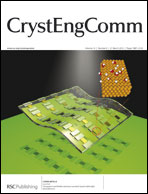In this work, the aromatic polycarboxylic acid, 1,3,5-benzenetricarboxylate (H3btc), has been utilized as a variable building block to perform an intensive study on the structure diversity of coordination polymorphs. The one-pot solvothermal reaction of Ni(NO3)2 with H3btc and 1,4-bis(imidazolyl)benzene (bib) ligands affords two novel polymorphous coordination polymers, {[Ni2(Hbtc)2(bib)3]·(H2O)}∞ (1) and {[Ni3(btc)2(bib)3(H2O)2]·(CH3OH)(H2O)4}∞ (2). In polymorphs 1 and 2, the aromatic acid adopts different bridging modes (κ1)-(κ1)-(κ1)-μ3 and (κ1)-(κ2)-(κ1-κ1)-μ4 to connect nickel ions into 2D (6,3) and (4,4) layers, which are further pillared by the bib ligand to form two binodal pillar-layer frameworks with Schäfli symbols of [63]·[614.8] and [44.62]·[48.67], respectively. The two polymorphs both exhibit a nickel–bib matrix, but the carboxylic acid ligand takes various coordination modes, finally leading to diverse topological structures. Furthermore, the deprotonation style of 1,3,5-benzenetricarboxylate steers the number of coordination mode around the metal ion, specifically the partially deprotonated Hbtc2− relating to one geometry-independent metal ion, and the fully deprotonated btc3− associating with two crystallographically independent metal ions. The variety of topological structure and metal composition indicates that the ligand H3btc plays an essential role in the assembly of the coordination polymorph. Magnetic studies reveal the weak ferromagnetic interaction within the binuclear cluster of polymorph 2.


 Please wait while we load your content...
Please wait while we load your content...